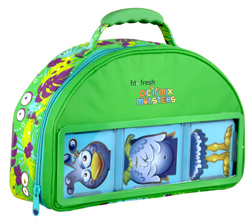Focus this month on switching your family over to whole grain products. Eating whole grains is a challenge for many of us and is up there in the top 2 ‘eating fights’ we have with our kids. Follow these five steps for success.
Step 1 Prepare Yourself by Being Label Savvy: Buying whole grain products can be very tricky indeed. Just take a look down the cereal or bread aisle: Made with Whole Grains, 100% Whole Grains, contains 1 serving of Whole Grains jumps out at us. What should you believe?
- Select those items that have a whole grain as the 1st ingredient on the ingredient list: “whole wheat”, “whole corn”, “rye berries”, whole oats” for example
- Don’t believe the front of the box. Avoid “made with whole grain” as these products can have only a tiny amount of whole grain in them
- Look for at least 3 grams of fiber per serving (2 grams of fiber if the serving is 80 calories or less)
- There are 2 Whole Grain stamps developed by the Whole Grain Council that you may see on the front or back of a package.
1. The Whole Grain stamp means that there is some whole grain in the product (a minimum of 8 grams of whole grain). Check the ingredient list to see what else in the product as these might not be the best choices.
2. The 100% Whole Grain stamp means the product is made with 100% whole grains. A minimum amount of whole grains in the product must be 16 grams. Products that have this stamp are a great whole grain choice.
Step 2 Begin with Breakfast: Most children start their day eating foods high in sugar and processed grains. Take one to two weeks to make over their breakfast to one that contains a serving of whole grains which will provide them the energy they need over a longer period of time
- Switch cereals made with processed grain to those made with whole grain (whole oats, whole corn, whole wheat
- Offer bagels or bread made with whole wheat (1st ingredient whole wheat) instead of processed wheat (white flour, enriched flour, wheat flour) bagels or bread
- Toaster cakes, donuts, cinnamon rolls, and many muffins (those made with processed flour) are no better for your child than offering them a piece of cake for breakfast. Breakfast does not need to be fun; it just needs to be healthy. Save these items for occasional treats.
- Serve oatmeal made with whole oats and less than 4 grams of sugar per serving
Step 3 Focus on Breads: Switching your child to whole grain bread is difficult and may require an incentive. Give younger children a sticker and older children 5 points every time they eat whole grain bread. When they reach a certain amount of stickers or points (you decide) reward them with something that they want: time with you alone or a toy for example.
Step 4 Find and Replace Processed Food: Look at the label of the crackers, pizza, pasta, rice, baked goods and other items made with grains and replace them with a whole grain product. You can do this slowly by adding ¼ the amount of whole grain to the processed grain. For example when making pasta, add some whole grain pasta (¼ the amount) to the pasta made with white flour. Continue until you have switched over to the whole grain product.
Step 5 Serve Other Whole Grains: There are many grains besides wheat, corn and oats that most of eat on a daily basis. Try quinoa, buckwheat, teff, Kamut, spelt, amaranth and millet to name a few.



 Dr. Debbie Kennedy (Dr. Deb) is a pediatric nutritionist with 23 years of experience in the field. She has worked with both Yale and Columbia Universities, and has developed programs for some of the industry’s luminaries such as Dr. David Katz and Dr. Mehmet Oz.
Dr. Debbie Kennedy (Dr. Deb) is a pediatric nutritionist with 23 years of experience in the field. She has worked with both Yale and Columbia Universities, and has developed programs for some of the industry’s luminaries such as Dr. David Katz and Dr. Mehmet Oz. 


Great idea about slowly working up the amount of whole grain pasta! I had never thought of that before. A study found that whole grain pasta was one of the hardest types of whole grain products to get kids to like. Seems funny to me — I just love it! But then, I’ve been eating whole grains for decades. I have an article with some more ideas to help kids like whole grains http://smartparentprogram.blogspot.com/2011/10/teaching-kids-to-like-whole-grains-is.html